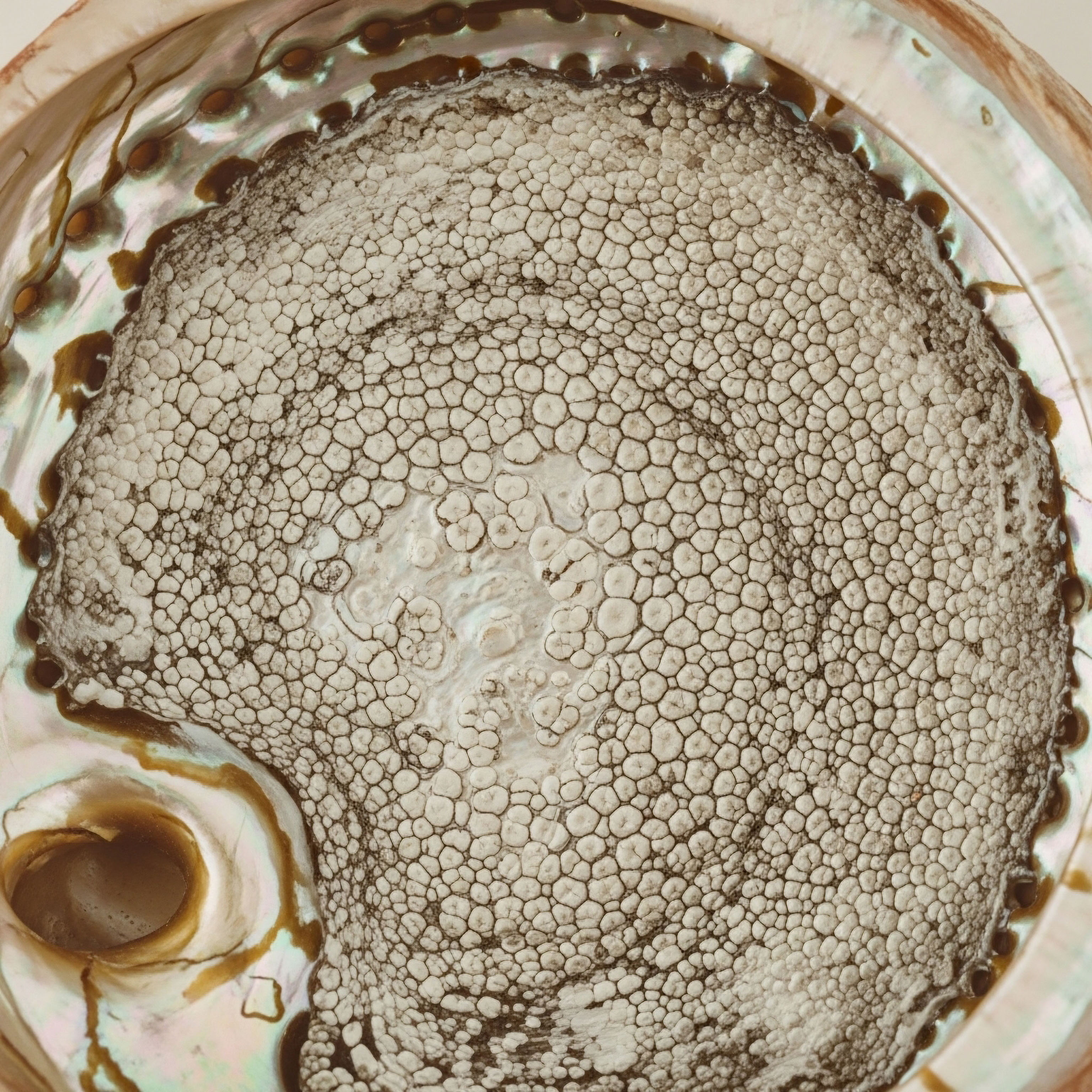

Fundamentals
The decision to cease testosterone replacement therapy often originates from a deeply personal place, a desire to restore a biological function that feels fundamental to one’s sense of self and future plans. You may be feeling a sense of uncertainty, wondering if your body can reclaim its natural hormonal rhythm.
This experience is a valid and common part of the health journey. The process you are considering is one of biological recalibration. Your body possesses an innate and intelligent system for governing its own hormonal symphony, a network known as the Hypothalamic-Pituitary-Gonadal (HPG) axis. Understanding this system is the first step toward actively supporting its reawakening.
Imagine your body’s hormonal regulation as a highly sophisticated thermostat system for a complex home. The hypothalamus, a small region at the base of your brain, acts as the central control unit. It constantly monitors the levels of hormones in your bloodstream, including testosterone. When it senses that levels are low, it sends out a specific signal, a molecule called Gonadotropin-Releasing Hormone (GnRH). This is a precise, targeted message sent directly to the next component in the chain.
The pituitary gland, often called the master gland, is the recipient of this GnRH signal. Think of it as the thermostat’s main operational hub. Upon receiving the GnRH message, the pituitary is stimulated to produce and release two critical messenger hormones into the bloodstream ∞ Luteinizing Hormone (LH) and Follicle-Stimulating Hormone (FSH).
These hormones are the direct communicators to the gonads, or testes in the male physiology. They travel through the circulatory system with a singular purpose, carrying instructions from the brain’s central command.
When LH and FSH arrive at the testes, they initiate two separate but coordinated processes. LH signals specialized cells, the Leydig cells, to produce and release testosterone. This is the primary function that elevates the body’s testosterone levels. Concurrently, FSH acts on another set of cells, the Sertoli cells, which are the architects of sperm production, a process called spermatogenesis.
The health and function of these Sertoli cells are entirely dependent on receiving this consistent signal from the pituitary. This entire interconnected network, from the brain to the testes, is what governs both your testosterone levels and your fertility.
The body’s hormonal system operates as a precise feedback loop, where the brain directs testicular function through specific signaling molecules.
When you undertake a hormonal optimization protocol like TRT, you are introducing testosterone from an external source. The body’s HPG axis, being incredibly efficient, senses that testosterone levels are adequate. In response, the hypothalamus reduces its GnRH signal. This is a natural and expected physiological adaptation.
The control unit determines that no more testosterone is needed, so it quiets the entire production line. Consequently, the pituitary gland reduces its output of LH and FSH. Without these stimulating signals, the testes decrease their own production of testosterone and slow down the process of spermatogenesis. This is the biological reason for the suppression of fertility during therapy. The system is not broken; it has simply been placed in a state of hibernation by the presence of external hormones.
Discontinuing the therapy removes this external signal. This action creates a void that the HPG axis is designed to fill. The process of restoring fertility is the process of waking this system back up.
It involves encouraging the hypothalamus to resume its GnRH pulses, prompting the pituitary to send out LH and FSH, and supporting the testes as they begin to respond to these signals once more. Lifestyle modifications, specifically targeted diet and consistent exercise, are powerful tools in this reawakening process. They do not simply support health in a general sense; they provide the specific biochemical and metabolic environment that encourages the HPG axis to restore its natural, robust rhythm.

The Foundational Role of Diet
The foods you consume provide the raw materials for every single biological process in your body, including the synthesis of hormones and the creation of new cells. A nutrient-dense, whole-foods-based diet is the bedrock upon which hormonal recovery is built. Think of your diet as providing the essential building blocks for the machinery of fertility. Without the right parts, the machinery cannot function optimally, regardless of the signals it receives.
Your endocrine system is particularly sensitive to the quality of your caloric intake. Hormones like testosterone are synthesized from cholesterol, making healthy fats a non-negotiable component of a fertility-supporting diet. Sources like avocados, olive oil, nuts, and seeds provide the necessary precursors for steroid hormone production.
Similarly, proteins are broken down into amino acids, which are essential for cellular repair, enzyme function, and the very structure of sperm cells. Adequate protein intake from lean meats, fish, eggs, and legumes ensures that the testes have the resources they need to rebuild and function effectively.
Carbohydrates also play a vital role, primarily in managing the body’s energy balance and insulin response. Insulin is a powerful metabolic hormone that is intricately linked with the HPG axis. Consistently high levels of insulin, often caused by diets rich in processed sugars and refined carbohydrates, can create a state of insulin resistance.
This condition disrupts the delicate signaling between the brain and the gonads, potentially hindering the recovery of LH and FSH pulses. Opting for complex carbohydrates from sources like vegetables, whole grains, and legumes provides sustained energy and helps maintain stable blood sugar levels, creating a more favorable metabolic environment for hormonal balance.

Exercise as a Biological Stimulant
Physical activity is a potent modulator of the endocrine system. Exercise is a form of positive stress that signals the body to adapt and become stronger and more efficient. From the perspective of fertility recovery, its benefits are multifaceted, influencing everything from hormonal signaling to cellular health and stress reduction.
Resistance training, such as weightlifting, has been shown to acutely increase testosterone levels. This type of exercise stimulates muscle growth and repair, processes that are hormonally demanding and can encourage the HPG axis to become more active. It also improves insulin sensitivity, which, as mentioned, is a key factor in maintaining healthy hormonal communication. By making your cells more responsive to insulin, resistance training helps lower circulating insulin levels and reduces the metabolic disruption that can interfere with fertility.
Cardiovascular exercise, both moderate-intensity and high-intensity interval training (HIIT), contributes by improving blood flow, managing body weight, and reducing systemic inflammation. Healthy circulation is essential for delivering hormones and nutrients to the testes and removing waste products.
Maintaining a healthy body composition is also critical, as excess adipose tissue (body fat) contains an enzyme called aromatase, which converts testosterone into estrogen. While some estrogen is necessary for male health, elevated levels can further suppress the HPG axis, creating a negative feedback loop that hinders recovery. Exercise helps manage body fat, thereby helping to maintain a healthy testosterone-to-estrogen ratio.
The journey of restoring fertility after discontinuing a hormonal protocol is an active one. It involves creating an internal environment that is conducive to the natural re-establishment of your body’s own powerful biological rhythms. Strategic choices in diet and a consistent commitment to exercise are your primary tools for facilitating this process, providing the resources and the stimulus for your HPG axis to come back online, fully and effectively.


Intermediate
Advancing beyond the foundational understanding of the HPG axis, the practical application of lifestyle interventions requires a more granular, systems-based approach. Improving fertility outcomes after TRT cessation is a process of systemic recalibration. Diet and exercise act as powerful epigenetic modulators, influencing how your genes express themselves and directly impacting the hormonal cascades that govern spermatogenesis.
This section explores the specific mechanisms through which these interventions exert their effects and how they can be structured to support a post-therapy recovery protocol.
The recovery timeline for the HPG axis is variable and depends on factors like the duration of therapy, dosage, and individual physiology. Generally, upon cessation of exogenous testosterone, the body begins the process of re-establishing its own production.
LH and FSH levels are expected to start rising within the first few weeks, with a peak occurring around the third or fourth week. However, the maturation of sperm (spermatogenesis) is a longer process, taking approximately 60 to 70 days. Therefore, a consistent and targeted lifestyle strategy should be viewed as a minimum three-month commitment to see meaningful changes in fertility markers.

What Is the Direct Impact of Nutrition on Hormonal Pathways?
A strategic nutritional protocol for fertility recovery focuses on three primary areas ∞ providing hormone precursors, managing insulin sensitivity, and mitigating oxidative stress. These elements work in concert to create an optimal biochemical environment for the HPG axis to function.

Macronutrients as Hormonal Building Blocks
The composition of your macronutrients has a direct and measurable effect on your endocrine system. The focus should be on nutrient quality and its metabolic impact.
- Dietary Fats ∞ These are the direct precursors to steroid hormones, including testosterone. The type of fat consumed is significant. Monounsaturated fats (found in olive oil, avocados, and almonds) and saturated fats (found in coconut oil, grass-fed butter, and animal proteins) are integral to testosterone production. A diet severely restricted in these fats can compromise the Leydig cells’ ability to synthesize testosterone, even when LH signaling is restored. Polyunsaturated fats, particularly omega-3 fatty acids (found in fatty fish like salmon and sardines, as well as walnuts and flaxseeds), are also vital. They form the building blocks of cell membranes, ensuring that hormone receptors on the surface of cells are fluid and responsive. Omega-3s also have potent anti-inflammatory properties, which helps to protect delicate testicular tissues from damage.
- Proteins and Amino Acids ∞ Adequate protein intake is essential for the synthesis of enzymes and peptides that are critical for fertility. The amino acid L-arginine, for example, is a precursor to nitric oxide, a molecule that improves blood flow to the reproductive organs. L-carnitine is another amino acid that plays a key role in sperm metabolism and motility. Ensuring a consistent supply of high-quality protein from a variety of sources provides the full spectrum of amino acids needed for these functions.
- Carbohydrates and Insulin Management ∞ The relationship between insulin and the HPG axis is a critical control point. A diet high in refined carbohydrates and sugars leads to chronic hyperinsulinemia. Elevated insulin levels are associated with increased activity of the aromatase enzyme, leading to higher conversion of testosterone to estradiol. This elevated estradiol then provides stronger negative feedback to the hypothalamus and pituitary, suppressing the release of LH and FSH and counteracting your recovery goals. A diet centered on low-glycemic, high-fiber carbohydrates from vegetables, legumes, and select whole grains helps to stabilize blood sugar and insulin levels, thereby supporting a more favorable hormonal ratio and reducing suppressive feedback on the HPG axis.

Micronutrients the Catalysts of Fertility
While macronutrients provide the fuel and building blocks, micronutrients act as the spark plugs and lubricants for the enzymatic machinery of fertility. Deficiencies in key vitamins and minerals can create significant bottlenecks in both testosterone production and spermatogenesis.
| Micronutrient | Role in Male Reproductive Health | Dietary Sources |
|---|---|---|
| Zinc | Acts as a cofactor for over 200 enzymes, essential for testosterone synthesis, sperm formation, and motility. Zinc deficiency is strongly correlated with low testosterone and poor sperm quality. | Oysters, beef, pumpkin seeds, lentils, shiitake mushrooms. |
| Vitamin D | Functions as a steroid hormone. Receptors for Vitamin D are found in the hypothalamus, pituitary, and testes. It is directly involved in modulating LH secretion and improving testosterone levels. | Sunlight exposure, fatty fish (salmon, mackerel), fortified milk, egg yolks. |
| Selenium | A critical component of antioxidant enzymes like glutathione peroxidase, which protect developing sperm from oxidative damage. Essential for sperm morphology and motility. | Brazil nuts, tuna, sardines, grass-fed beef, turkey. |
| Folate (Vitamin B9) | Plays a crucial role in DNA synthesis and repair. Adequate folate levels are necessary for producing genetically healthy sperm and reducing the risk of chromosomal abnormalities. | Leafy greens (spinach, kale), asparagus, Brussels sprouts, lentils, avocado. |
| Vitamin C & E | Powerful antioxidants that work synergistically to protect sperm from free radical damage. Vitamin C is concentrated in seminal fluid, while Vitamin E protects the fatty membranes of sperm cells. | Citrus fruits, bell peppers, broccoli (Vitamin C); Almonds, sunflower seeds, spinach (Vitamin E). |

How Does Exercise Specifically Recalibrate the HPG Axis?
Exercise is a systemic signal that communicates directly with the central nervous system and endocrine organs. The type, intensity, and consistency of exercise determine the nature of this signal. A well-designed program for post-TRT recovery will incorporate elements of resistance training, cardiovascular conditioning, and active recovery.
Consistent, structured exercise sends powerful signals to the brain to re-establish and maintain robust hormonal production.
A study on men with hypogonadism found that regular exercise could increase the probability of a maintained response after TRT cessation by tenfold. This highlights the profound impact of physical activity as a therapeutic tool.

Comparative Impact of Exercise Modalities
Different forms of exercise trigger distinct physiological and hormonal responses. A combination is often most effective for comprehensive recovery.
| Exercise Modality | Primary Hormonal Impact | Mechanism of Action |
|---|---|---|
| Resistance Training | Increases testosterone, growth hormone, and improves insulin sensitivity. | Stimulates muscle protein synthesis, which requires anabolic hormone support. Large, compound movements (squats, deadlifts) create the greatest hormonal stimulus. Improves glucose uptake by muscles, reducing the need for insulin. |
| High-Intensity Interval Training (HIIT) | Boosts testosterone and enhances mitochondrial density. | Short bursts of maximal effort followed by brief recovery periods create a potent metabolic stressor that upregulates hormone production and improves the energy-producing capacity of cells, including those in the testes. |
| Low-Intensity Steady-State (LISS) | Reduces cortisol and manages systemic inflammation. | Activities like brisk walking or cycling at a moderate pace help to lower the primary stress hormone, cortisol. Chronically elevated cortisol is catabolic and suppresses the HPG axis. LISS improves cardiovascular health and blood flow without over-stressing the system. |
Overtraining represents a significant risk during this recovery phase. Excessive volume or intensity without adequate rest can lead to chronically elevated cortisol levels, which will actively work against your goal of restarting the HPG axis. Listening to your body, prioritizing sleep, and scheduling rest days are as important as the training sessions themselves.
Sleep is when the majority of hormonal regulation and tissue repair occurs. Consistently achieving 7-9 hours of high-quality sleep per night is a non-negotiable aspect of any serious recovery protocol.
Integrating these specific dietary and exercise strategies creates a powerful, synergistic effect. You are not merely waiting for your body to recover; you are actively providing the precise biochemical inputs and physiological stimuli required to accelerate and solidify the restoration of your natural fertility.
This approach complements and can even enhance the efficacy of clinical protocols like the use of Gonadorelin or Clomiphene, which are designed to directly stimulate the pituitary and testes. Lifestyle modification is the foundation that makes these targeted therapies more effective.


Academic
A sophisticated analysis of fertility restoration post-TRT requires a deep exploration of the molecular conversations occurring between metabolic pathways and the endocrine system. The efficacy of lifestyle interventions like diet and exercise is rooted in their ability to modulate the cellular machinery within the hypothalamus, the pituitary, and most critically, the testicular microenvironment.
This section examines the specific biochemical mechanisms through which these interventions influence the Hypothalamic-Pituitary-Gonadal (HPG) axis, focusing on cellular energy sensing, inflammatory signaling, and the gene expression that governs steroidogenesis and spermatogenesis.
The suppression of the HPG axis by exogenous testosterone is a classic example of negative feedback inhibition. High circulating levels of androgens are detected by receptors in the hypothalamus, leading to a downregulation in the pulsatile secretion of Gonadotropin-Releasing Hormone (GnRH).
This, in turn, reduces the synthesis and release of Luteinizing Hormone (LH) and Follicle-Stimulating Hormone (FSH) from the anterior pituitary. The consequences at the testicular level are profound ∞ diminished LH stimulation of Leydig cells leads to a shutdown of endogenous testosterone production, while the absence of FSH stimulation of Sertoli cells halts the critical support needed for the maturation of germ cells, leading to azoospermia or severe oligozoospermia.
The recovery from this state is a complex biological process that can be significantly influenced by the body’s metabolic status.

The Role of Metabolic Fitness in HPG Axis Reactivation
The concept of “metabolic fitness” extends beyond simple weight management. It refers to a state of high insulin sensitivity, low systemic inflammation, and efficient cellular energy utilization. This state is arguably a prerequisite for the optimal functioning of the HPG axis.

AMPK the Master Metabolic Regulator
One of the key molecular players in this interplay is AMP-activated protein kinase (AMPK). AMPK is a cellular energy sensor, activated when the ratio of AMP to ATP increases, such as during exercise or caloric restriction. Once activated, AMPK works to restore energy homeostasis by stimulating glucose uptake and fatty acid oxidation while inhibiting energy-consuming processes like protein and lipid synthesis.
In the context of fertility, AMPK’s role is nuanced. In the hypothalamus, AMPK activation has been shown to influence GnRH neuron firing, thereby modulating the pulsatility of the entire axis. More directly, within the testes, AMPK activity in both Leydig and Sertoli cells is critical.
Exercise-induced AMPK activation in skeletal muscle improves systemic insulin sensitivity, which indirectly benefits the testes by reducing ambient insulin and inflammation. This creates a more favorable environment for Leydig cell steroidogenesis. Research indicates that a metabolically healthy state, characterized by appropriate AMPK signaling, supports the efficient conversion of cholesterol into testosterone.

Inflammation and Oxidative Stress the Silent Suppressors
Chronic, low-grade inflammation is a potent disruptor of endocrine function. Pro-inflammatory cytokines, such as Tumor Necrosis Factor-alpha (TNF-α) and Interleukin-6 (IL-6), are often elevated in states of obesity and metabolic syndrome. These cytokines can directly interfere with GnRH secretion from the hypothalamus and can also impair the function of Leydig cells, reducing their capacity to produce testosterone in response to LH.
Oxidative stress, a condition where the production of reactive oxygen species (ROS) overwhelms the body’s antioxidant defenses, is particularly damaging to sperm. The high lipid content of sperm cell membranes makes them extremely vulnerable to lipid peroxidation by ROS. This damage impairs sperm motility, morphology, and DNA integrity.
A diet rich in antioxidants (Vitamins C and E, selenium, carotenoids) and polyphenols (from colorful plants, green tea, and dark chocolate) directly counteracts this process. Exercise, while acutely increasing ROS production, leads to a long-term upregulation of the body’s endogenous antioxidant systems, such as superoxide dismutase (SOD) and glutathione peroxidase. This adaptive response makes the testicular environment more resilient to oxidative damage over time.

Can Specific Dietary Strategies Alter Testicular Gene Expression?
The nutrients consumed are not merely passive building blocks; they are bioactive molecules that can influence gene expression through epigenetic modifications. The composition of dietary fatty acids, for example, can alter the lipid profile of cellular membranes, including those of the mitochondria within Leydig cells where testosterone synthesis occurs. This can impact the efficiency of the enzymatic steps involved in converting cholesterol to pregnenolone and subsequently to testosterone.
Furthermore, micronutrients like zinc and vitamin A (retinol) are essential for gene transcription related to fertility. Zinc is a key structural component of zinc-finger proteins, which are transcription factors that bind to DNA and regulate the expression of genes involved in steroidogenesis. Retinoic acid, the active form of vitamin A, is indispensable for the initiation of spermatogenesis, acting on Sertoli cells to support the differentiation of spermatogonia.
A dietary pattern that provides a rich supply of these specific nutrients can therefore be seen as a tool for optimizing the genetic and cellular machinery required for fertility restoration. It moves beyond caloric management to a form of targeted biochemical support.
- Management of Aromatase Activity ∞ Adipose tissue is the primary site of aromatase activity in men. Lifestyle interventions that lead to a reduction in body fat percentage have a direct impact on lowering the rate of testosterone-to-estradiol conversion. This is critically important post-TRT, as excessive estrogenic feedback can potently suppress the re-emerging GnRH pulses. Resistance training and HIIT are particularly effective at improving body composition.
- Support for Post-Cycle Therapy (PCT) Protocols ∞ Clinical interventions post-TRT often include agents like clomiphene citrate or tamoxifen (Selective Estrogen Receptor Modulators, or SERMs) and sometimes hCG or gonadorelin. SERMs work by blocking estrogen receptors in the hypothalamus, tricking the brain into thinking estrogen levels are low, which then stimulates GnRH and subsequently LH/FSH release. Lifestyle factors that lower systemic estrogen levels (via fat loss) can work synergistically with SERMs, potentially allowing for greater efficacy. Similarly, agents like gonadorelin, which directly stimulate the pituitary, function best in a low-inflammation, nutrient-replete environment.
- Neurotransmitter and Mood Support ∞ The recovery period can be associated with mood fluctuations and low energy as the body adapts to the absence of exogenous testosterone. Exercise is a well-documented modulator of neurotransmitters, increasing levels of dopamine, serotonin, and endorphins. A diet rich in tyrosine (precursor to dopamine) and tryptophan (precursor to serotonin) from high-quality proteins can further support neurological function and well-being, improving adherence to the overall recovery plan.
In conclusion, the influence of diet and exercise on fertility recovery after TRT is not a peripheral or secondary consideration. These interventions are potent effectors of the core biological processes that govern HPG axis function.
They operate at a molecular level, modulating cellular energy sensing, reducing inflammatory and oxidative stress, providing essential cofactors for enzymatic reactions, and supporting the optimal gene expression for both steroidogenesis and spermatogenesis. A scientifically-grounded lifestyle protocol is a foundational component of any comprehensive strategy for restoring endogenous hormonal production and fertility. The evidence strongly suggests that such interventions can significantly improve outcomes, potentially shortening recovery times and leading to a more robust and stable return of natural function.

References
- Kwon, Young-Gyun, et al. “Predictive Factors of Efficacy Maintenance after Testosterone Treatment Cessation.” The World Journal of Men’s Health, vol. 37, no. 1, 2019, p. 83.
- Ramasamy, Ranjith, et al. “Recovery of Spermatogenesis Following Testosterone Replacement Therapy or Anabolic-Androgenic Steroid Use.” Asian Journal of Andrology, vol. 18, no. 2, 2016, pp. 162-167.
- Patel, Anup, et al. “Understanding and Managing the Suppression of Spermatogenesis Caused by Testosterone Replacement Therapy (TRT) and Anabolic-Androgenic Steroids (AAS).” Journal of Clinical Medicine, vol. 12, no. 5, 2023, p. 1944.
- Swinton, Paul, et al. “The Effectiveness of Weight-Loss Lifestyle Interventions for Improving Fertility in Women and Men with Overweight or Obesity and Infertility ∞ A Systematic Review Update of Evidence from Randomized Controlled Trials.” Obesity Reviews, vol. 23, no. 1, 2022, e13348.
- “Restoring Fertility After Stopping TRT.” Southwest Integrative Medicine, 2021.
- Hawksworth, Dorota J. and Arthur L. Burnett. “Hormonal Therapies in Men’s Health.” Urologic Clinics of North America, vol. 47, no. 4, 2020, pp. 495-505.
- Ng Tang Fui, Mark, et al. “Effects of Testosterone Treatment on Body Composition and Metabolic Profiles in Men with Obesity and Low-Normal Testosterone.” The Journal of Clinical Endocrinology & Metabolism, vol. 101, no. 11, 2016, pp. 4289-4297.

Reflection
You have now explored the intricate biological systems that govern your hormonal health and the powerful influence you can exert upon them. The information presented here, from the foundational mechanics of the HPG axis to the nuanced molecular impact of nutrition and exercise, is designed to be a map.
It details the terrain of your own physiology. A map, however, is only as valuable as the journey it inspires. The true work begins with the first step you take, the first conscious choice you make in your daily life that aligns with the goal of systemic recalibration.
Consider the signals you send your body each day. Every meal, every workout, every hour of sleep is a message, a piece of information that your cells interpret and respond to. What conversation do you want to have with your biology? This journey is one of partnership.
It involves listening to the subtle feedback your body provides ∞ your energy levels, your mood, your strength ∞ and adjusting your approach with patience and consistency. The path to restoring your body’s innate rhythm is unique to you.

A Perspective on Personal Biology
The knowledge you’ve gained is a tool for self-awareness. It allows you to move from a position of uncertainty to one of empowered action. Understanding the ‘why’ behind a protocol transforms it from a set of instructions into a collaborative effort with your own body.
As you implement these strategies, observe the changes not just in future lab results, but in your present state of being. The process of reclaiming one function often leads to a greater sense of vitality and well-being across your entire system. Your biology is not a fixed state; it is a dynamic and responsive process. You are an active participant in that process, and the potential for positive adaptation is always present.

Glossary

testosterone replacement therapy

follicle-stimulating hormone

luteinizing hormone

testosterone levels

spermatogenesis

sertoli cells

hpg axis

endocrine system

fertility recovery

insulin sensitivity

resistance training

lifestyle interventions

diet and exercise

mechanisms through which these interventions

oxidative stress

leydig cells

gonadorelin

through which these interventions

cellular energy

metabolic fitness

gene expression




